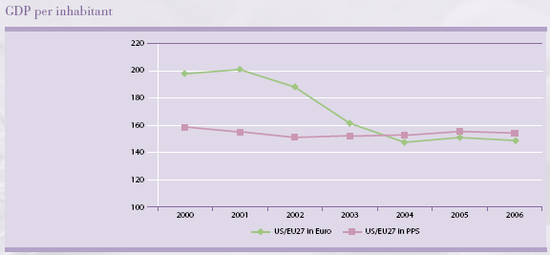Archive:Comparing prices across countries
- Published in Sigma - The Bulletin of European Statistics, 2007/02
For many years, Eurostat, together with the OECD, has run the European comparison programme. The aim is to compile purchasing power parities, which are a kind of alternative exchange rates that allow a comparison of, for example, GDP across countries, that is unaffected by differences in price levels between the countries.
Introduction
To compile purchasing power parities (PPPs), prices of a basket of comparable and representative goods and services are collected in all participating countries. For consumer products, in total about 3 000 products are priced. In addition, information is gathered about prices for housing, investment goods (including construction services) and government services.
46 countries participate
Currently, 46 countries participate in the European comparison programme, of which 37 are European countries, whose survey work is coordinated by Eurostat, while the other nine countries are non-European OECD countries. The 37 countries in the Eurostat part of the exercise comprise all 27 Member States, three EFTA countries, three candidate countries and four western Balkan countries, although the latter are not yet fully integrated.
Data collection on consumer goods and services are carried out in continuous cycles. Each cycle takes three years and comprises six surveys, two each year. This means that each product is priced once every three years. For the intervening years, the prices are extrapolated with suitable consumer price indices. The advantages of this approach are that it reduces the response burden on participating countries, it enables them to include the price surveys in their regular programme of data collection and it fosters continuity of expertise in the NSIs.
Key for allocation of EU Structural Funds
The PPPs are compiled on an annual basis. Twice a year, in June and December, the latest price survey results are incorporated to calculate the freshest PPPs. The main derived indicator is real GDP per inhabitant, which is the GDP per head of the population divided by the PPPs. An important use of this indicator is for the allocation of the Structural funds within the EU. Regions where real GDP per capita is less than 75 % of the EU average (taken over a period of three years) are eligible for Structural funds.
Comparing price levels of products
Another output of considerable interest to users is the resulting price level indices. For any category of products, these are calculated by dividing the PPPs by the exchange rates. If the result is higher than 1, the price level for this product in this country is higher than the EU average. If the result is lower than 1, the price level is lower than the average. Eurostat publishes the results of the price surveys at regular intervals. For example, in March 2007, Eurostat published two 'Statistics in focus' with comparative price level indices for pharmaceuticals and furniture. Public interest for this information is generally high.
Why PPPs and not exchange rates?
Why would one use PPPs instead of exchange rates when converting economic indicators into a common currency? Consider the graph above comparing GDP per inhabitant of the EU-27 and the United States.
The green line shows the ratio of GDP per inhabitant between the US and the EU-27 if the US GDP was converted into euros using the exchange rate. As the development of the exchange rate between the euro and the US dollar was rather volatile in this period, it appears as if US citizens have had a turbulent time, especially in 2002 and 2003. However, that would of course not reflect their actual situation in those years. If we would divide the US GDP by the PPP between the EU-27 and the US the trend would be as depicted by the pink line, i.e. an almost stable pattern. “PPS” stands for “Purchasing power standard” which is an artificial currency unit defined so that GDP per inhabitant in the EU-27 in euros equals that in PPS.
‘The world’s largest statistical initiative’
The PPPs calculated by Eurostat and the OECD are also used in the international comparison programme (ICP) run by the World Bank. This programme, labelled recently by The Economist as the ‘world’s largest statistical initiative’, comprises currently around 150 countries around the world. The ICP is to publish PPPs for the year 2005 in the second half of 2007. These data will be extremely useful for understanding the global distribution of income and will be used extensively for poverty analysis.

